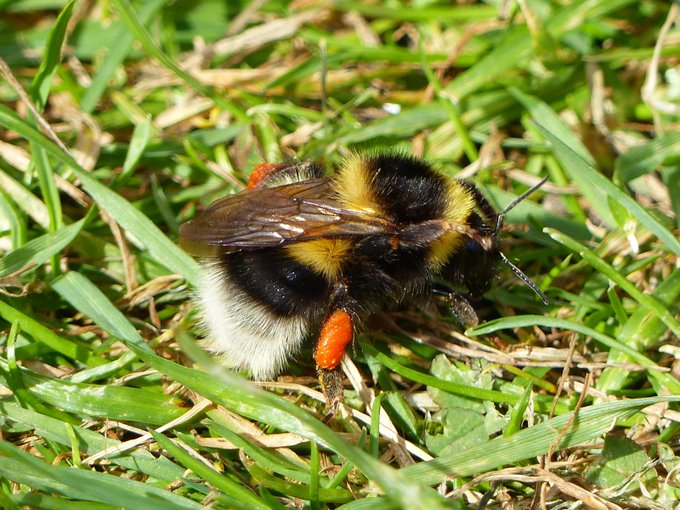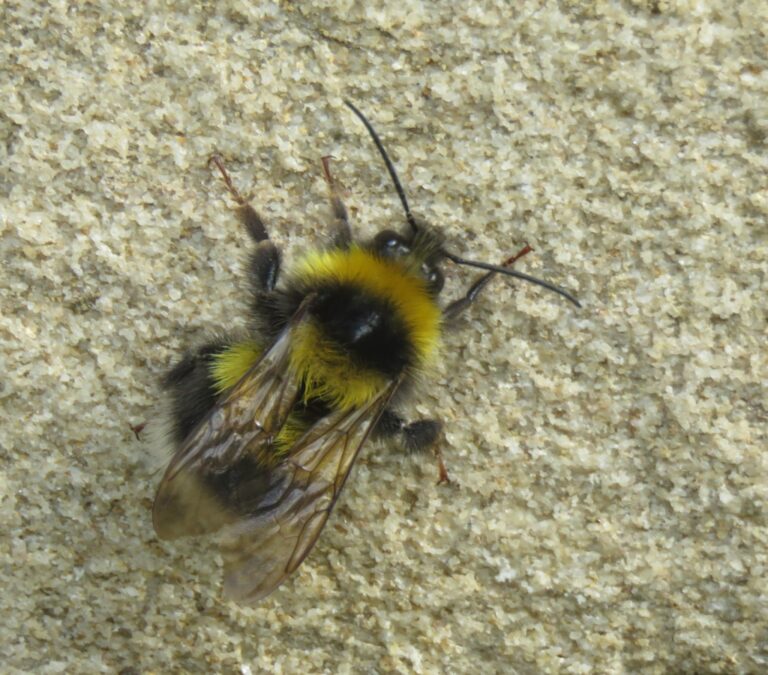Bombus hortorum
Fast facts
- Common name(s)
- Garden Bumblebee, Small Garden Bumblebee
- Scientific name
- Bombus hortorum
- Bee group
- A species of social bumblebee
- When to see it
- March – October
Description
The Garden Bumblebee nests underground, typically in old rodent burrows. With the longest tongue of any bumblebee, this species is particularly fond of plants with deep or tubular flowers.
Identification
All castes (queens, workers and males) have the same colour pattern. Garden Bumblebees have a white tail with three yellow bands. A key feature is the very long, thin face that is often described as ‘horse-shaped’.
The first yellow band is behind the head at the top of the thorax. There is a yellow midriff band, formed from a yellow band at the bottom of the thorax and a band at the top of the abdomen.
Queens and workers
Queens are large bees and workers resemble small queens. Queens are first out in the year and workers are seen throughout spring and summer. Both have pollen baskets on their hind legs that appear shiny without the presence of pollen.
Did you know?
The Garden Bumblebee was first recorded in the North East from Longbenton in 1853.
Males
Males have the same colour pattern as the females and the long face. However, they have longer, curved antennae and lack shiny pollen baskets. Sometimes there is also a small tuft of yellow hair on the top of the head. However, males do not have yellow hair on their face like that of similar white-tailed bumblebees.
More images of the Garden Bumblebee can be found here

Spotted this bee?
Share your sighting of the Garden Bumblebee and other North East Bee Hunt target species to contribute to the conservation and study of our region’s bees.
Similar species
White-tailed Bumblebee
White-tailed Bumblebees (Bombus lucorum agg.) also have white tails but do not have a midriff yellow band. The yellow band on the abdomen is lower down and White-tailed Bumblebees have short faces unlike Garden Bumblebees. Male White-tailed Bumblebees also have yellow facial hair unlike that of Garden Bumblebees.
Heath Bumblebee
The Heath Bumblebee (Bombus jonellus) also has a white tail and a double midriff band. However, the Heath Bumblebee has a very short face, and is smaller and fluffier.
Ecology
The Garden Bumblebee nests underground, typically old rodents burrows, and nests can contain up to 150 workers. Paired with its long face, the Garden Bumblebee has the longest tongue of any bumblebee. This means that you will find this bumblebee on deep, tubular flowers such as Clovers, Vetches and Foxgloves. In flight, the tongue is often held outstretched as the bee approaches a flower.
More information on the Garden Bumblebee can be found here
Regional Distribution
The Garden Bumblebee is considered a common and widespread bumblebee in the North East. Last year, the North East Bee Hunt received 130 records of this bumblebee, stretching from Holy Island to the North Pennines. The Garden Bumblebee is one of the common ‘Big Seven’ bumblebees in Britain.




